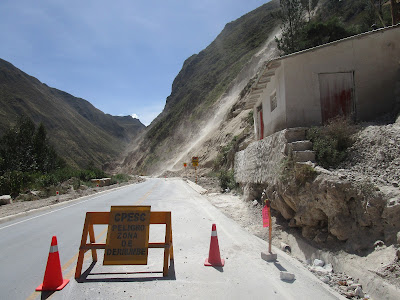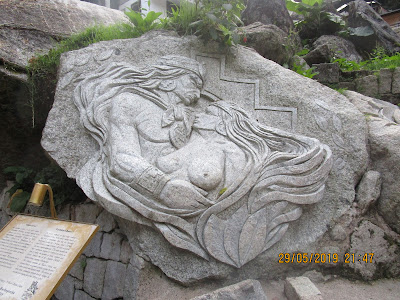Finally we got to Ollantaytambo train station where we waited for our train. We were in carriage B and had numbered seats. We had to show our tickets and passports.
The train was bound for Aguas Calientes, now more commonly known as Macchu Picchu Pueblo, where we would have a late lunch and then a 20 minute uphill walk . The train journey brought us through some very scenic countryside. We could see Mount Veronica and its glacier. We also saw some Andean terraces along the Urubamba river. The guardsman was very good at pointing out things we should photo
When we got to Aguas Calientes we went to a restaurant where I chose fettucine with vegetables - a bit of a bad choice as the pasta was doused in soy sauce and was inedible. However, Sarah and Jim each gave me a slice of their pizza so I didn't starve!
The centre of Aguas Calientes - Aguas Calientes means hot waters in Spanish because of its thermal baths. The centre is full of souvenir shops and restaurants as the town exists solely for tourism with people arriving by train every day overnighting in the village and visiting Machu Picchu the next day.
This gives you an idea of the street we had to walk up - 20 minutes or more - to get to our Luna Muna Eco Hotel. Needless to say everyone else got there much faster than breathless me! After settling in to our rooms - fortunately we were on the first floor - we did a bit of a walkabout around the area, and then had coffee and shared a huge shortbread biscuit sandwiched with dulce da leche.
We explored the area in the vicinity of our hotel and discovered a series of sculptures carved into the same granite rock in which the hot springs are set. Seemingly these sculptures were part of the "Pachamama Rimac" contest that was organised in the village in September 2017 - so a relatively new exhibition. They were sculpted by renowned Cusco artists and artisans from Aguas Calientes and present the contemporary view of Andean man towards the worldview of the ancient men who created Machu Picchu. I found them fascinating.
This was the area in which we saw all the sculptures
Some of these sculptures speak of Pachamama or Mother Earth - the one that gives us its fruits to be able to feed us, the one that gives life, usually represented as a woman with long hair and Andean features. She is sometimes represented as naked or as pregnant
This is The Family - father, mother and child.
This is a sculpture of the Apus or mountain god holding a baby in his hands. The baby wears the traditional chullo, Andean knitted cap, According to the story of this sculpture it represents the protection of the Apus given to the children of Aguas Calientes many years ago during a huayco - Andean term for a mudslide and flash flood caused by torrential rains high in the mountains.
This is entitled Forbidden Love. It is a beautiful sculpture of an Inca man embracing a woman. Both are semi-nude and it reflects erotic love. According to the history of this sculpture, Pachamama must always be with the Apus, the masculine energy of Andean man, and that both the earth and the mountains represent Andean duality. In this case, however, the god of wind, Wayra, is the one that falls in love with Pachamama. The artist wanted to represent in this sculpture the hidden love of two beings who can never be together.
This is a sculpture of Wiracocha - the creator god who lived in the divine world. The myths of the Inca consider him the creator of the sun, the moon, the stars and everything in nature.
It was early to bed for us - Jim in bed by 6.45 pm - as we had to be up for breakfast at 4.40 am in order to be ready to leave for Machu Picchu at 5.20 am to be there for sunrise. It was a bit noisy but I had to remember that it was only early evening!






























No comments:
Post a Comment